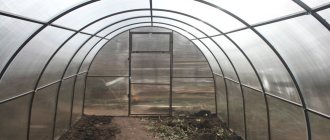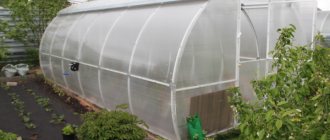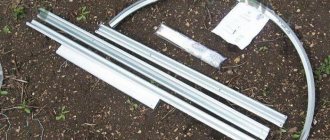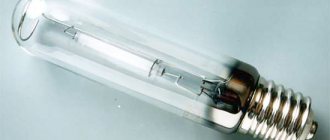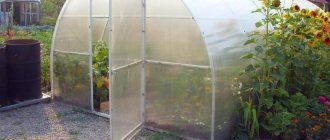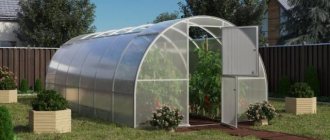Today, many Russians who have household plots or summer cottages are thinking about building greenhouses. This solution allows you to diversify your diet - it’s nice to see fresh vegetables and herbs on your table throughout the year, and also significantly support the family budget in our difficult times.
So, let’s assume that your greenhouse is already ready: the foundation has been built, the frame has been erected, there is glazing (cellular polycarbonate or film), the soil has been filled, the beds have been created. The issues of watering and heating are well thought out. It would seem that everything has been taken into account. However, this is not quite true. Have you thought about lighting? And is it necessary? After all, during the day there is enough natural light, but at night the plants need to rest. Why do plants need additional lighting and what it should be like, what lamps exist for heating a greenhouse today, we will try to tell you in this article.
For normal development and intensive growth, plants require a large amount of energy. They get it from light rays: this is the sun in nature, and during greenhouse cultivation - special lamps.
What kind of light should be in a greenhouse?
Undoubtedly, solar lighting is most beneficial for agricultural crops, so it is necessary to use it as much as possible. However, the length of daylight (in autumn, winter and spring) does not allow crops to be grown fully - after all, plants need solar energy for at least ten to twelve hours a day. In any season (except summer) you will need to use lamps to illuminate your greenhouses.
To create comfortable conditions for crop growth, simple rules should be followed.
- Artificial lighting of a greenhouse with LED lamps (as well as any other) should not completely replace sunlight. It should only serve to extend daylight hours. Therefore, the greenhouse lamp must be mounted in such a way that it does not restrict the penetration of sunlight.
- In a greenhouse, lighting can be intense for up to 16 hours a day (this depends on the crop being grown).
- Plants should not be illuminated throughout the day: instead of growing crops, you will get the opposite result - weakening and depletion of sprouts.
- Plants require rest and darkness for 6 hours a day.
What is the lighting for?
At a low level of lighting , be it a lack of daylight or low quality artificial lighting, even shade-loving plants will begin to wither, which will lead to their inevitable death .
Living nature is organized according to the main process of survival and development, and this process is called photosynthesis .
By producing
chlorophyll, plants are able to absorb carbon dioxide, but this is possible only in sunlight, which does not happen in the dark.
Insufficient consumption of sunlight can deprive a culture of normal development:
- change in shape and growth activity;
- exclusion of fruiting (the plant simply will not bloom, and therefore there will be no ovaries);
- unnatural elongation of cuttings and stems.
Artificial lighting will help maintain the normal reproduction of fruit and vegetable crops in greenhouses, greenhouses and conservatories, as well as avoid troubles associated with a lack of sunlight. Lamps for plants in a greenhouse can replace natural lighting in a greenhouse in winter just as well.
What to look for when choosing lamps?
First of all, you should inquire about the manufacturer of the lamp. Well-known brands guarantee quality and service (which is sometimes not cheap). Chinese lamps are attractive mainly for their low price, but, unfortunately, you will not receive any guarantees or service.
Lamp power (W)
This indicator indicates how much energy a greenhouse lamp consumes per hour of operation.
Emitted Energy
Knowing this parameter, you can calculate how many lamps are needed to sufficiently illuminate the greenhouse.
Optimal choice of heating system
Recently, greenhouse semicarbonate has become increasingly popular, which automatically eliminates the need for constructing a gable-type structure.
- If we consider this option taking into account reliability, we can see that it is in such a building that the strip foundation is best preserved.
- Thanks to concreting around the entire perimeter, it becomes possible to maintain optimal temperature conditions regardless of what the weather is like outside.
Based on this, it should be noted that only an arched greenhouse with sheathing made of cellular polycarbonate sheets acts as the most acceptable option in all respects.
But, before giving preference to this option, you need to pay attention to the main advantages and disadvantages.
Light spectrum
It should be recognized that to date, a lamp for a greenhouse has not yet been created that is capable of 100% transmitting the spectrum of the sun's rays. Therefore, experienced owners often combine lamps to achieve better results. Biological scientists have been able to establish that different light spectrums have different effects on cultivated crops.
For example, violet and blue rays accelerate photosynthesis - the plant becomes stronger and grows faster. Yellow and green rays slightly inhibit photosynthesis. In this case, the plant stems become taller and thinner. Orange and red rays are the best energy for fruiting and flowering of plants, but you need to know that if there is an excess of them, the plant can even die. Ultraviolet rays increase resistance to cold; they also form vitamins in the fruits and leaves of plants.
Heating a greenhouse from below: bottom heating device using IR film
To directly heat the soil from below, infrared systems are used to heat greenhouses in the form of special films laid in the ground. Installation is carried out according to one of the selected schemes:
Horizontal. In this case, the film is placed under the beds to a depth of at least 50 cm from the surface.
Vertical. The film heater is installed vertically in the ground between the beds and along the perimeter of the greenhouse.
Bottom heating is more difficult to install, but more economical, since radiant energy directly heats the soil and air at the lower level of the shelter, which reduces energy consumption.
Bottom heating of the greenhouse.
Diagram of connecting the film to the network and thermostat.
This method also has some disadvantages. For example, when replacing soil in a greenhouse, which many vegetable growers carry out annually to prevent plant diseases, care must be taken not to damage the system
Fluorescent lamps
This type of lamps is most often used in small greenhouses or greenhouses. They are universal both in cost and in application - they can suit many. Ideal light quality can be achieved by combining warm white light with cool white light.
This greenhouse lamp can operate for about 2000 hours. Often, for a comprehensive effect on plants, an ultraviolet lamp is additionally installed, which prevents the development of harmful bacteria on plant leaves and in the soil. But it should be recognized that for large greenhouses it is better to choose a different type of lighting, since too much fluorescent lighting will be required.
Advantages
- First of all, the efficiency of the device. Emit almost full spectrum light. Therefore, they can be used at every stage of crop development - from growing seedlings to full ripening of the crop.
- Affordable price.
- High brightness.
- Such lamps do not heat up and therefore do not disturb the microclimate of the greenhouse.
- Do not require special technical skills for installation.
Flaws
- A fluorescent lamp for a greenhouse is too large and may block access to natural sunlight during the daytime.
- Has low light output.
- Reacts to changes in external temperature - for its normal operation a temperature of +25 degrees is required. When it is lowered, the lamp may simply go out.
- Does not withstand high humidity (no more than 70%).
The lamps are mounted above the plants in a horizontal position, fixed in a rectangular metal frame. They are placed at a height of up to fifty centimeters for light-loving plants, and at a height of fifty centimeters and above for plants that prefer not too bright lighting.
Installation of ceiling heaters
A small infrared ceiling heater for domestic use can be easily installed with your own hands. This can be done by a professional electrician or an ordinary person, the main thing is to follow all the steps exactly. You need to start with the correct placement of the equipment; you cannot place the device less than 30 cm from the furnishings and structures of the room. Now you need to decide what is included in the kit of a regular ceiling heater:
- the infrared device itself (this can be of any design, including glass panels);
- device suspension elements;
- heating electric heating element;
- heat-emitting plate;
- fasteners, tension plate;
- screws, bolts, etc.
Diagram of an IR lamp for a greenhouse.
Often, heaters for installation on ceilings come with all the necessary fasteners, these can be cables, chains, etc. In this case, it is possible to ideally determine the height of the heater and, if necessary, adjust it.
Installation steps include:
- first you need to choose the installation location, mark it with a simple pencil;
- then the infrared heater is pulled out of the packaging and placed on a horizontal, flat surface with the plate facing down;
- a ring screw is screwed into the ceiling, chain links are hung for fastening, and their reliability is checked;
- the heater is suspended on a chain at the selected height between the brackets (all screws must fit into the prepared grooves, after which they are screwed tightly);
- the heat-emitting plate is wiped with alcohol just before connection;
- the ends of the cable are connected to the heater and the fixed network in strict accordance with the diagram provided by the manufacturer;
- the device with the thermostat should be located approximately 1.5 m from the floor level; the device itself should not be in the field of action of the heater rays, in a draft or near other heat sources.
There are other installation options, for example, using terminals for glass heaters. These household appliances are a decorative panel made of tempered glass, which is attached to the ceiling using a terminal block and self-tapping screws
There are gas heaters, the installation principle of which is also different, so when purchasing, always pay attention to how exactly the device will be mounted, whether you have the conditions for its installation
Infrared heaters today are used not only for heating a private home, but also for shops, cafes, industrial workshops, even for open spaces. Not all heating devices are capable of this. At the moment, this is the most promising type of heaters, which have a variety of advantages.
During installation, you can maintain the shortest length from the device itself to structures and furnishings, that is, IR heaters are absolutely safe. Manufacturers today offer us various models, including gas appliances for ceiling mounting, industrial and household, and outdoor. The devices themselves can be made of special film, glass, and have various heating elements. Installing household IR devices is also very simple; usually, installing ceiling mounts is sufficient; the device itself is fixed using special brackets, terminal blocks, or suspended on chains and cables.
Mercury vapor lamps
To grow plants in greenhouses and greenhouses, mercury lamps are produced - DRLF, which promote active photosynthesis of plants. Their emission spectrum is close to red, so it is better to use them during fruit ripening.
However, you should know that such devices have more disadvantages than advantages. These include:
- Dangerous operation. If you break such a lamp, you will not be able to collect mercury balls. In this case, it is necessary to change the soil and destroy all plants.
- Such a lamp cannot be thrown away after its service life has expired. There is a special disposal method for this.
- Differs in too intense ultraviolet radiation.
The best manufacturers
The heater is chosen for more than one season. When you give your hard-earned money for an electrical appliance, you want to be sure that it will last long enough. The world's best manufacturers, whose popular models do not require additional advertising, can guarantee high quality.
Ballu
Many buyers have managed to appreciate the products of this international holding, a world leader in the production of climate control equipment. The company's product range includes more than three hundred items of household and industrial equipment:
- humidifiers and dehumidifiers; coolers and heaters;
- convection, infrared, ground, water, gas heaters;
- hand dryers;
- air conditioners, split systems, etc.
It all started at the end of the 20th century with a small company producing refrigerators and freezers BLR “Bai Lunyu Refrigerated Equipment Entertainment” in the town of Keelung near Taipei, the capital of Taiwan. Today it is a multinational corporation headquartered in Hong Kong.
MO-EL
The Italian company Moel by SALKA specializes in the production of pest control products. At the same time, climate control devices have been developed and produced: IR heaters, hand dryers, hair dryers, heating equipment, etc. The functionality of some models can be supplemented with various devices, incl. air ionizer. The popularity of the company's models is explained by the constant search for new technical solutions.
Timberk Tech
The Swedish manufacturer is a recognized leader in the production of climate control equipment. The company's products undergo rigorous quality control at each processing stage. The latest technologies are used in the production process. Buyers highly value products bearing the Timberk brand for their high quality, affordable prices and the regular appearance of new products on sale.
Electrolux
A Swedish company known throughout the world for its high-quality household appliances. All housewives know her products. These are washing machines and dishwashers, irons and steam generators, vacuum cleaners and kitchen appliances. Among all this diversity, there was a place for all kinds of heaters, convection, infrared, etc. Users note the high build quality and excellent design of Electrolux products. In 2014, the company supplied equipment to hotels in Sochi, in preparation for the Olympic Games.
High pressure sodium lamps for greenhouses
They are classified as emitting red and orange parts of the spectrum. Experts suggest that crops will receive the blue part of the spectrum from natural daylight.
Advantages
- The main argument in favor of such lamps can be considered their efficiency. Such devices consume a small amount of electricity and at the same time are cheaper than analogues in terms of efficiency, for example, LED lamps. This is very important if you need to illuminate a large greenhouse.
- In addition, sodium lamps for greenhouses last up to twenty thousand hours.
- The light output significantly exceeds that of fluorescent lamps.
Flaws
- Sodium lamps for greenhouses produce a lot of heat. This can be considered both an advantage and a disadvantage of the device. On the one hand, such lamps are quite effective for greenhouses in winter. They can become an additional source of heating. But in spring, autumn, and, of course, in summer, such heating can harm the plants, and the owner will have to constantly monitor the temperature in the greenhouse.
- Such lamps have an adverse effect on the development of young plants - the red part of their spectrum causes the seedlings to stretch out and the stems to become thin.
- Sodium lamps can attract harmful insects.
- These lights contain a mixture of mercury and sodium inside. Therefore (like mercury lamps) they are not safe to use.
- Sodium lamps cannot be connected if the voltage fluctuations are more than 5%.
Device design
In general, the structure of the apparatus is the same and simple: an incandescent body enclosed in a housing open on one side. The housing is equipped with a reflector that directs radiation to a given area.
This structure makes the device completely safe for any greenhouse - with a coating of polycarbonate, glass and even film, especially when compared with a gas heater. Infrared radiation is directed downward, and the body, although it heats up, is not to such an extent as to affect the polycarbonate.
Various devices can be used as an incandescent body.
Tungsten filament in a quartz tube - tungsten, when passing current, heats up to high temperatures, and quartz perfectly conducts heat and dissipates it. A vacuum is created in the quartz tube.
Another option is to pump an inert gas into the tube instead of a vacuum. The substance helps extend the life of the device, since here the metal particles return back to the filament.
In a carbon element, the role of a filament is played by carbon fiber, also placed in a quartz tube. The efficiency of this design reaches 95%, while it has very low current absorption. However, heating a greenhouse with infrared heaters of this kind is rarely organized, since the device is expensive and quite fragile. The simplest, most reliable and affordable is a tubular heating element heater. The combination of aluminum heat-conducting plates and low-temperature heating elements - up to 300 C, ensure operation for 6-7 years
The efficiency of the models reaches 80%, the advantage is the low temperature of the plates, no more than 60%. However, in greenhouses, whether film or polycarbonate-coated, the devices are rarely used due to their high cost.
LED lamps for greenhouses
More often they are called LED lamps. Despite the fact that they are quite expensive, this type of lighting is becoming increasingly popular. By making a combination of such lamps, you can achieve light with the desired spectral composition - use individual lighting for any variety of plants. Lighting the greenhouse with LED lamps allows you to adjust the light intensity depending on the height of the devices and their number. For example, during the period of plant growth, you can give them more light with a blue spectrum, while fruits are ripening - with red and orange.
Advantages
- Economical energy consumption.
- Operation at very low voltage.
- Long service life (up to 100 thousand hours).
- They do not heat up - the microclimate of the greenhouse is not disturbed.
- The possibility of plants getting burned is eliminated, even if the distance to them is as close as possible.
- LEDs are resistant to moisture, temperature changes and mechanical damage.
Flaws
- There is only one drawback to such lamps - high cost.
How to choose lamps for a greenhouse and calculate their number
The most popular are LED phytolights for plants and sodium lamps. They lead in energy consumption, luminescence spectrum and radiation power. Infrared lamps are used only for heating, and they have to be supplemented with other equipment.
Tomatoes require at least 15 hours of light, cucumbers - 12 hours. The greenery will delight you with its harvest, even if the illumination lasts only 10 hours during the day.
In order for the lighting of a greenhouse for growing plants to be effective, you need to calculate in advance how many lamps you will need.
Before calculating lighting for a greenhouse, you need to consider:
- the selected type of lamp and its power;
- type of culture that needs additional lighting;
- height of placement of lamps;
- time of year for additional lighting;
- area of a greenhouse or other room.
On average, to illuminate 1 square meter of a greenhouse you need a lamp with a power of 70-100 W. If, for example, the area of the greenhouse is 6 sq.m., then for it you can choose 4 HPS lamps of 150 W each or approximately 20 pieces of LED greenhouse phytolamps with a power of 25 W. You can also make calculations using special online calculators.
Infrared lamps
This lamp is ideal for heating a greenhouse in winter. It must be said that today more and more greenhouse owners prefer new infrared systems. These systems are effective and economical and are capable of creating conditions in the greenhouse that are as close to natural as possible.
Advantages
- Infrared lamps for a greenhouse warm up the plants and soil well.
- The air temperature rises from the energy given off by the greenhouse walls and soil. This is the main difference between IR systems and electrical and convective methods, in which air (heated) is forced upward while plants and soil remain cool.
- Such heaters, if desired, can be equipped with thermostats that at a certain point stop the heat supply and resume heating when the temperature drops.
- Warms up the air quickly. IR radiation does not pose a danger to humans or plants.
- They don't dry out the air.
- The system is almost silent.
As you can see, there are many greenhouse lights available today. Having become familiar with their disadvantages and advantages, each owner will be able to choose a suitable lighting source for his greenhouse.
Operating principle of IR heater
Infrared heaters differ in operating principle from other devices; they heat not the air, but the surrounding objects, that is, they act on the principle of sunlight.
Diagram of heat distribution in a greenhouse.
When taking pictures of the situation in a room with thermal cameras using infrared devices, you can observe the following picture: the maximum temperature is observed near the equipment and near the floor surface, that is, heating is felt immediately after switching on. But with a conventional heater, warm air rises to the top, that is, you have to wait a very long time for the temperature below to rise, and this significantly increases energy consumption. That is, we can conclude that infrared heaters are much more economical; it is recommended to choose them when electricity consumption is critical and comfort is a priority.
Lamp and film heaters with minimal energy consumption
To install an effective and simple IR heater, ceiling lamp and film structures are often used, which are very easy to install and their energy consumption is quite economical.
Diagram of a lamp IR heater for greenhouses.
Lamp infrared devices use halogen lamps with a tungsten filament in a flask filled with a mixture of argon and nitrogen as a radiation source. The power of such lamps is 150-250 W, which is quite enough to heat an ordinary living space. Lamps for such devices are produced in different ways:
- conventional infrared mirrors, which are similar to conventional lighting lamps, but emit a larger amount of IR rays;
- mirror red infrared lamps with a bulb made of dark red glass, they give little light, but more heat, and energy consumption is much less.
Film infrared heaters are attractive because they do not have a housing, that is, they are a film with carbon paste one micron thick. This film has copper contacts. You can choose such a heater if you need to heat the device to a maximum of 110 degrees, and the average heating temperature is 30-45 degrees Celsius. The energy consumption of a film heater is not very high; it is often used for installation not only on ceilings, but also for floor heating.
Gas panels and long wave IR
Gas IR heaters are mainly used for local heating of small outdoor areas. This allows you to create comfortable conditions on verandas, outdoor cafes, and terraces. Often gas appliances are designed in the form of elegant modern lanterns that serve as design decoration.
Types of IR radiation.
The device itself consists of gas cylinders hidden under the base of the umbrella. The consumption of the cylinder is very economical, it lasts for 22-25 hours of continuous operation, so they are often taken on picnics, placed on playgrounds, sports grounds, and parks. There is enough power to feel comfortable even at sub-zero temperatures.
Gas ceiling heaters are used when a mobile heat source is needed on an area from 9 to 60 sq.m. The fuel is bottled liquefied gas.
Most often, long-wave devices are used to heat a house, the radiation source of which is a special aluminum alloy plate with a special coating. Such a plate is heated by heating element up to 300 degrees Celsius, between it and the body there is a heat-insulating material that ensures heating of the body itself to only 50 degrees, that is, the heat is directed exactly where it is needed.
Household IR devices of this type are produced in the form of rectangular cases; they are mounted on the ceiling with special brackets; the angle of inclination of the device can be easily adjusted. Long-wave devices are very convenient for heating not only in residential premises, they can also be successfully used for offices, shops, and kindergartens.
Reviews from greenhouse owners
According to people who grow vegetables in greenhouses, different lighting can be used. Both fluorescent and LED lamps are suitable for this. In the first case, the low cost of the lamps attracts, in the second, the rapid growth of plants. However, most greenhouse owners prefer LEDs, despite their high cost. They fully justify their price with low power consumption and long service life.
Many people refuse mercury lamps due to the fact that if such a lamp breaks, it can cause many problems. If additional heating is needed, experienced vegetable growers recommend using infrared lamps.
Kinds
When choosing an IR heater, one takes into account several criteria.
Source of released energy
Existing types of “infrared” can be:
- electrical;
- gas (halogen);
- diesel.
Heating element type
Electric heaters are equipped with the following types of heating elements.
- Ceramic - they have increased strength, heating for them is a matter of minutes, they cool down just as quickly;
- Heating elements - the advantages of tubular electric heaters are reliability and stable maintenance of the set temperature;
- Carbon - the design of such a heater is represented by vacuum tubes with carbon-hydrogen fibrous filler.
Form
In appearance, heaters can be infrared lamps of various formats, film panels or tapes. Compared to lamps, film or tapes provide the greatest energy savings and heat the soil more evenly.
Installation method
Before purchasing a “personal sun”, you should immediately decide on the placement of the device.
Depending on the mounting method, the equipment can be:
- mobile;
- stationary.
There are no questions regarding the first one - this is a portable equipment that can be moved to the desired location using wheels or special legs.
You can experiment with the installation of stationary models as much as you like, since they are available in several types:
- ceiling;
- wall;
- baseboard;
- hanging.
Suspended models differ from ceiling ones in the principle of fastening. Suspension-type heaters are built into a suspended ceiling structure, which is pre-designed for the placement of devices. To fix hanging devices, use special brackets and anchor bolts in increments of 5 to 7 cm.
The optimal place to place baseboard heaters is under a window, which helps realize their full potential by blocking the cold and drafts coming from outside.
Heating temperature
IR equipment differs in the degree of heating of the device itself.
Devices can be:
- low temperature – up to 600°C;
- medium temperature – from 600 to 1000°C;
- high temperature – more than 1000°C.
Devices with medium or high temperatures are good in spacious and high greenhouse pavilions. In these cases, warm air can be guaranteed to reach the ground, and not just circulate in the middle.
Emission range
In accordance with this parameter, IR equipment is:
- long wave;
- medium wave;
- shortwave.
According to Wien's law, there is a direct relationship between the wavelength and the temperature of the surface on which the radiation hits. Under high-temperature radiation, the wavelength increases, but at the same time they become hard and become dangerous.
Lighting devices in the form of lamps with a maximum filament temperature of 600°C are good for heating large industrial greenhouses. Long-wave equipment eliminates strong heating. It is usually used in small greenhouses on a summer cottage.
IR heaters have additional options.
- Many models of infrared equipment have a thermostat (temperature regulator) that is responsible for maintaining the set temperature.
- Any thermal heater must be equipped with a thermal switch that reacts to overloads and automatically turns off the device, preventing it from overheating.
- To ensure comprehensive safety, IR equipment is also equipped with insulators that prevent contact of the housing with the heating element.
- Particularly advanced models have a light indication that informs the user about a problem that has arisen so that he can quickly navigate and take measures to eliminate it.
- Spontaneous shutdown of floor-standing models occurs when tipped over, which simultaneously prevents damage and reduces the risk of fire to zero.
- The presence of the Antifrost system is designed to protect the heating device from the formation of ice. Even if the heater is used in harsh Russian winters, you don’t have to worry about the performance of the IR equipment.
- Many models of infrared heaters have a timer, which makes operation much more comfortable. Thanks to the ability to set the desired on and off times, you can reduce fuel costs.
Suspended heating
The simplest type of infrared heating of a greenhouse is the use of suspended systems. They should be hung from the ceiling or walls of the greenhouse and connected to an energy source and directed to the beds. Due to their compactness and low weight, they can be installed in a greenhouse for as long as needed. It all depends on the area of the structure and their power. Heaters or lamps can be used as hanging systems.
Heaters and lamps are equally resistant to temperature changes, mechanical stress, high air humidity, and various chemical reagents. It is recommended to install the IR heater at a height of at least 1 meter from the plants. The height can be determined more accurately based on the size of the greenhouse and the temperature required for good plant growth. One should also take into account the fact that the higher the IR heating system is located, the larger the area it will be able to cover. But at the same time, the plants will receive less heat.
Also read: How to make a winter greenhouse yourself?
